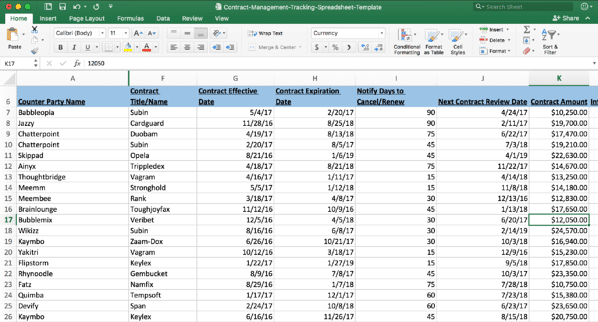Contracts are not just one-dimensional documents. Unfortunately, most people view contracts as documents—pieces of paper (physical or metaphorical) with page numbers, content/clauses written on the page, and signed in ink or squiggly line eSignatures. But contracts are more than that. A contract should be a living, breathing, connected cross-section of data that drives action in and protects your business, not something that weighs you down. This is why tracking contract data as part of your contract management is incredibly important to your business.
But why does this matter? The information within your business contracts is vital to defining the relationships you share with your customers, employees, partners, and others—and you need to have an easy way to decipher every single contract you sign and what’s inside.
Centralize and track data within current business contracts
Tracking these types of information in contracts is very difficult to do because the contracts executed within your business don’t all look the same. Legal term changes, new versions, and redlines complicate how you centralize contracts in a way that’s easy to search and analyze.
Usually, a good system can easily break down as you scale because your colleagues will feel it’s easiest to just send a document and work with that document to track the changes within it. Then, when the contract needs to be executed, the document will be flattened into a non-editable PDF that’s digitally or physically signed.
Where does that leave the contract manager trying to understand the contents of that contract afterwards? Usually, it requires them to re-read the finalized, executed contract and put the important provisions or changes into a spreadsheet that looks something like this:
I know, I know. Spreadsheets seem archaic to a lot of people. If you’re tracking contracts this way, though, you’re still ahead of most. Imagine how this spreadsheet would look within your business.
- Do you have something like this in place already?
- Do you know what’s inside your contracts?
- Do you track when contracts expire?
Highlighting key provisions in your contracts allows you to differentiate how customer, vendor, or employee relationships are defined.
Many of these data points can be tracked in Excel, a contract lifecycle management platform, or other SaaS tools. Companies like LegalSifter have even built an AI engine that helps companies extract this important information automatically. Yet most companies don’t have a real record (outside of an executed contract) of what was actually agreed to. Spreadsheets become difficult to manage, contract lifecycle management tools get unwieldy to adopt, and ultimately your important customer relationship definitions could get lost.
The result? Your customer gets angry when you don’t meet or exceed their expectations. Even worse—you could lose track of an important legal provision that ends up costing you a lot of money down the road.
Leverage contract data inputs to automate outputs
Service level agreements (SLAs), indemnification, limitation of liability, contract amount, start and end dates—all are important pieces of data to various parts of your organization. The information inside your contracts needs to be easy for the right people in your organization to discover and unlock.
To begin centralizing all of this information, think about the information inside your contracts as data that has both inputs and outputs.
One thing we’ve discovered and reiterate to our customers is this: the bulk of contracts are standardized, non-negotiated (or lightly negotiated) agreements and so there is a huge opportunity to make these kinds of contracts more data-driven.
In B2B, you might have a standard customer contract, SLA, Order Form, Contractor Agreement, Employment Agreement, etc. In B2C, you have online terms, scalable agreements that may be executed as a clickthrough (or clickwrap), vendor/supplier agreements, etc. The only difference among these contracts is the inputs into the agreement: Company name, job title, email address, amount, start date/end date, and a few provisions that might be unique for each contract.
These types of contracts are typically integrated into business processes that help scale and automate the outputs of the agreement which require some action from your business: onboarding, kickoff calls, or invoicing. The outputs are what actually happens as a result of the contract being executed. The more analytical you can be about breaking down the bits and bytes of these types of agreements, the more you can leverage the inputs to automate the outputs.
What do I mean? Most companies don’t connect the actual execution of a contract (i.e. the act of the contract being executed) to the actions that immediately follow. Typically, after a document is signed, the person who owns that document (the only person who knows what the contract says) will reach out internally about next steps. Some organizations leverage CRM to drive workflows that integrate to internal or third party systems to take the next action.
What are the implications of data-driven contracts on your business?
The more technology takes over every facet of our lives, the more efficient your business will need to be as you race to outpace your competition. Customer experience is one of the main differentiators left in the world—and as your business grows, technology is what helps you scale your customer experience. For contracts, your business can use technology to analyze important manual processes in your contracting experience that can be 1) scalable & automated and 2) customer focused.
For example:
- If you need to get contracts signed for changes in one of your contracts, could you build or integrate into a portal where your employees or customers already go?
- Can you use placeholders in standardized agreements for things that might be unique to each signer, and populate those fields so they’re stored and easy to search?
- Instead of printing and signing it, can you post your NDA for acceptance online (one of the largest use cases for standardized agreements) with an integration back to your CRM?
What if the contract could “talk” to your internal systems? The data inside the contract can connect to the core business processes that surround what happens next. As soon as a contract is executed, it knows to create an invoice with the right payment terms sent from Bill.com, Oracle, Xero, or QuickBooks Online. It also sends an automated email to the right folks to notify them that the contract is done. It adds a calendar invite for the renewal manager to make sure they check in near the end of the contract’s duration.
This is the power of treating contracts as data. Integrate the inputs, connect in real-time to the outputs.
Start treating contracts as data to improve business functions
Getting started is easy: Take 30-60 minutes thinking about your standardized contracts within your business and think through answers to the following questions:
- How are these typically executed today? Where would be the best place for them to be executed (in an app, in a portal, electronically on a phone)?
- Break down the key data points that are negotiated (if any). How are those inputs populated in a contract? Is there a current technology or process that assists with that?
- How are those data points tracked once the contract is executed? Does the legal team have visibility into that? What about other teams that may need access to the important pieces of a contract relevant to them (Operations? Support? HR?)?
Having a framework for how these agreements flow within your business and having goals for the ideal workflow and documentation are a must if you want to really begin streamlining these types of processes inside your business.
Our customers here at Ironclad have seen returns in the hundreds of thousands by having an amazing approach to how these flows can and should work within their business. The best part? It makes your customers’, employees’, and partners’ lives easier when contracts are more native, digital, and mobile-first because they’re populated by data, not documents. We believe this is the future.
Ironclad is not a law firm, and this post does not constitute or contain legal advice. To evaluate the accuracy, sufficiency, or reliability of the ideas and guidance reflected here, or the applicability of these materials to your business, you should consult with a licensed attorney. Use of and access to any of the resources contained within Ironclad’s site do not create an attorney-client relationship between the user and Ironclad.
- Centralize and track data within current business contracts
- Leverage contract data inputs to automate outputs
- What are the implications of data-driven contracts on your business?
- Start treating contracts as data to improve business functions
Want more content like this? Sign up for our monthly newsletter.




